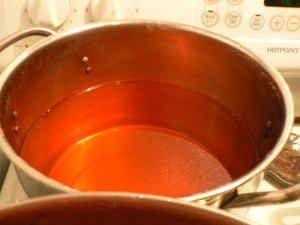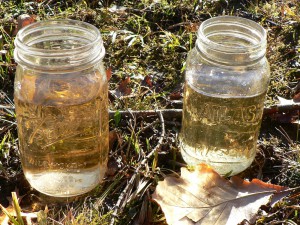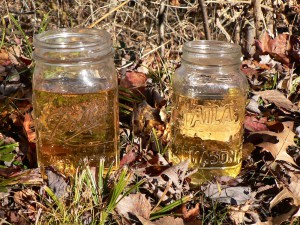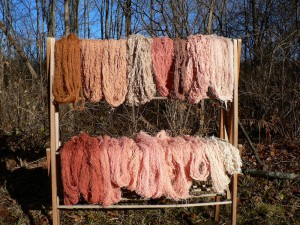If you read my last post, you may be wondering why I wasn’t totally content with my orange linen, as bright and cheery as it was. Basically it’s because I wanted pink. Light pink, to be exact. Light pink 40/2 linen, to be exact, and lots of it. Why? Well…!
A fortunate side-effect of my successful show with Amanda Quinby at the Shelburne Arts Co-op in Shelburne Falls in October was that I sold all of my usual inventory of naturally dyed linen bookmarks and hand-bound books with hand-woven cloth covers. Hence, I need to weave more! My main objective with this madder exhaust project was to create light pink 40/2 linen yarn for weaving heart-motif bookmarks in Huck Lace. I must confess that all the other lovely colors I obtained were just happy by-products in my quest for pink.
And I did get pink. When I began to formulate my hypothesis about the orange bath, which I will expound upon later, I decided that my best prospect for getting pink was to extract the roots again. Ta-da! I got a very rich rose-pink, and then gradually lighter pinks as I went along. I even extracted the roots a third time, and got slightly more blue shades of pink. I continued exhausting these two pink dyebaths until there was almost no color left at all. I heated and cooled them repeatedly for days and days, but despite this abuse the colors remained clear and lovely. Here’s how one of the pots looked about halfway through this process. It’s already pretty transparent:
And here are two jars showing the clarity of the two utterly exhausted pink dyebaths. There are two different views just because I thought the leaves and the light were so pretty!
So, in conclusion: I got to pink by extracting the roots a second and even a third time. I did not combine the dyebaths. I kept them separate. I added two Tums tablets to each potful of roots (a quickie way to add calcium to a madder bath, courtesy of Michele Wipplinger of Earthues). (12/26/2023 Edited to add: Michele Wipplinger died in 2020, a tremendous loss to the world. This link now links to the new Earthues website). But I did not check the pH nor add any other pH modifiers to make it more alkaline. I always kept the temperature below 160F (my personal standard for madder, though I have occasionally gone higher by accident).
Here’s the photo again of the range of colors I obtained. The colors on the top right (to the right of the blah grayish skein), and the colors on the bottom row, are the ones from the “pink” dyebaths.
In my next post I will try to explain, or at least make reasonable speculations about, the chemistry behind my orange and pink yarns.




